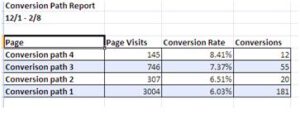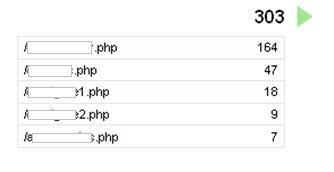In order to properly optimize your conversion rate, you don’t want to to track just the total number of conversions you generate at any given time. You need to understand the path users take through your site on their way to converting, and you need to understand which path is most successful.
I was reviewing the goal funnels within Google Analytics for a client the other day. This client has one contact form on their site, but there are four ways to arrive at this form (i.e. catalog request, direct contact form, request a custom quote). As you can see below, conversion path one had 181 conversions, which is much higher than the other paths.

However, when I broke down our traffic for each of my four conversion paths, I found that the third and four paths have a higher conversion rate. The total number of conversions is lower for these paths because they receive less traffic. Currently, our conversion path with the best conversion rate is not a statistically valid winner yet, but we may re-think which path we focus on.
The majority of pages on the site currently follow the first conversion path and this is why it generates so many leads. But since paths three and four have a higher conversion rate, we may alter the site in order to send more users through these channels. This may help increase our conversion rate, and lower our cost-per-conversion.
What is the moral of story? If users can convert on your site in multiple ways, constantly monitor the conversion rate for each path. The site I am working on has always sent users through our first conversion path (just standard process). We may be able to increase our conversion rate with a few changes, and focusing on other conversion points on the site.




